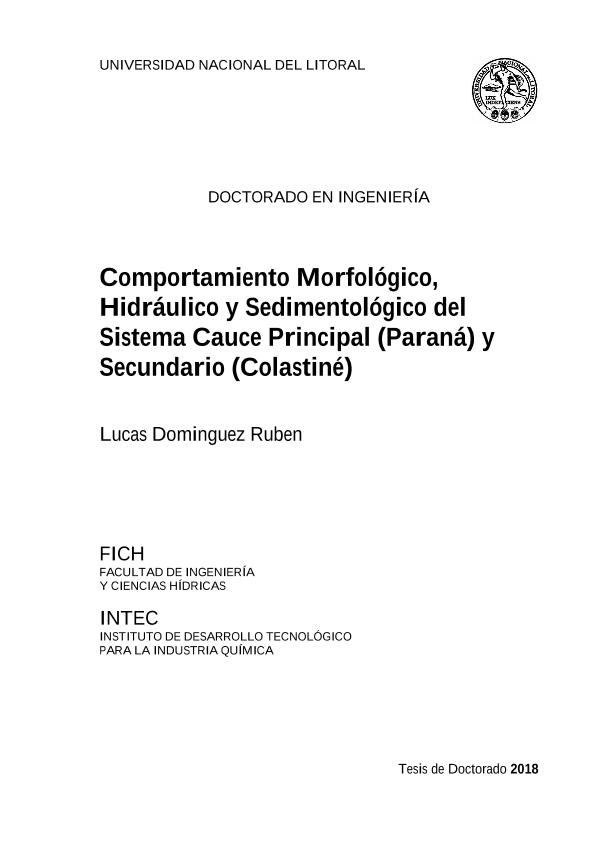Tesis doctoral
Los cauces secundarios, característicos de un sistema multicanalizado como el Paraná en su tramo medio, juegan un rol clave en la dinámica de relleno de la planicie aluvial y vinculan el cauce principal con los asentamientos poblacionales que se encuentran en las márgenes de la planicie. El río Colastiné es uno de ellos, y se encuentra caracterizado por una forma en planta de tipo meandriforme y elevada relación ancho/profundidad (B/H>50). El principal interés sobre estos cauces se centra en el entendimiento del comportamiento hidráulico y sedimentológico, para de esta forma poder gestionarlos, más aún cuando de estos depende el desarrollo socio-económico de una ciudad poblada como Santa Fe, Argentina. Es por eso que en esta tesis se indaga sobre los mecanismos hidrosedimentológicos y morfológicos actuantes en un gran cauce meandriforme, el río Colastiné, abarcando desde la partición del flujo y sedimento en su embocadura (bifurcación con cauce principal río Paraná) hasta su comportamiento generalizado de su tramo inicial (meandriforme). Lo novedoso de la presente tesis es el uso de tecnologías acústicas Doppler para cumplir dicho objetivo y además el desarrollo de códigos computacionales que permitan la transformación de la señal acústica a datos de concentración y transporte de sedimento suspendido. Adicionalmente se intenta abordar la fenomenología mediante la modelación matemática bi y tridimensionalmente tanto del flujo como del sedimento suspendido mediante la aplicación del modelo TELEMAC-MASCARET. Todo esto se acopla a un análisis histórico de la morfodinámica permitiéndonos discernir sobre el comportamiento actual y futuro del río Colastiné. In anabraching systems like the Paraná in its middle reach, characteristic geomorphological structures are secondary channels, which play a key role in the filling of the floodplain dynamics. They also link the mean channel with riverine settlements into the alluvial plain. The Colastiné River is an excellent example, with a meandering planform and a high width/depth relation (B/H>50). Main interest in these secondary channels is centered on the hydraulic and sedimentological understanding for an appropriated management. Even more, when their monitoring is addressed to the socio-economic development of coastal populated cities, such the case of Santa Fe city, Argentina. The present Thesis are to study the hidro-sedimentological mechanisms acting on a large meandering channel, the Colastiné River, Paraná, Argentina, including process such flow and sediment partition at its mouth as well as flow and sediment transport general behavior within the initial reach of this channel. Innovation is not only given by the use of acoustic Doppler technology, i.e., the acoustic Doppler current profilers, but also by the development of computational codes to process acoustic signal to obtain concentration and suspended sediment transport data. A powerful tool calibrated for the present work is the simulation software TELEMAC-MASCARET, used worldwide in the scientific community to solve governing equations for 2D and 3D free-surface flows through the finite elements method. In addition to the above mentioned, an historical analyzes of Colastiné River morphodynamics is made to discern about actual and future behaviors.
Comportamiento morfológico, hidráulico y sedimentológico del sistema cauce principal (Paraná) y secundario (Colastiné)
Dominguez Ruben, Lucas Gerardo

Director:
Szupiany, Ricardo Nicolas

Codirector:
Farias, Hector Daniel

Fecha de publicación:
15/03/2018
Idioma:
Español
Clasificación temática:
Resumen
Archivos asociados
Licencia
Identificadores
Colecciones
Tesis(CCT - SANTA FE)
Tesis de CTRO.CIENTIFICO TECNOL.CONICET - SANTA FE
Tesis de CTRO.CIENTIFICO TECNOL.CONICET - SANTA FE
Citación
Dominguez Ruben, Lucas Gerardo; Szupiany, Ricardo Nicolas; Farias, Hector Daniel; Comportamiento morfológico, hidráulico y sedimentológico del sistema cauce principal (Paraná) y secundario (Colastiné); 15-3-2018
Compartir



